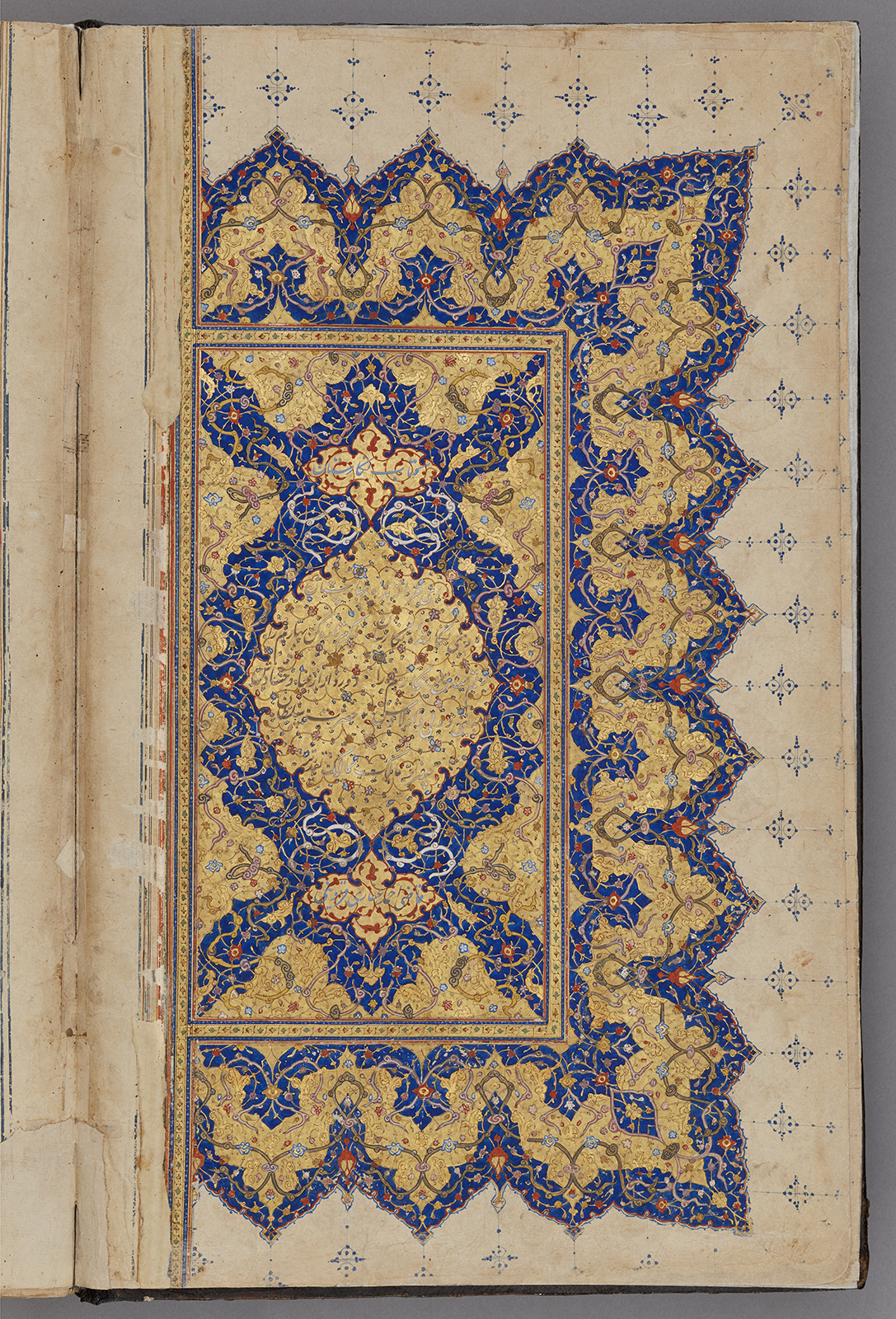Click on the image to zoom
Frontispiece, from a manuscript of Nigaristan
- Accession Number:AKM272.f2v
- Creator:Author: Ahmad b. Muhammad Ghaffari, Persian, died 1567 Scribe: Ahmad al-Shirazi
- Place:Iran, Shiraz (probably)
- Dimensions:38.7 cm × 25 cm × 6.4 cm
- Date:1573-74 CE/980 AH/AH 980
- Materials and Technique:Ink, opaque watercolour, and gold on paper
This double-page frontispiece is from an intact manuscript of the Kitab-i Nigaristan by Ahmad Muhammad Ghaffari (1504–67/68). Completed in 1552, the Kitab-i Nigaristan is a collection of historical anecdotes and incidents, written in prose and focusing largely on peculiarities in Iranian history. The manuscript’s 350 tales are narrated in chronological order, beginning with the Prophet and Imam Ali, continuing to the Abbasid caliphs and other rulers of Iran, and concluding with the Turkmen rulers. Dated 1573, this manuscript in the Aga Khan Museum Collection was copied by the scribe Ahmad Shirazi. It contains 44 illustrations executed in the Shiraz style.
See AKM272 for more information about the manuscript and links to the other illustrations.
Further Reading
These opening pages are called Sarlauh. Folio AKM272.f2v consists the title of the book and the beginning of the chapter. In the centre of the vertical rectangle is a golden rhomboid-shaped shamsa, a medallion with blue illuminations. The first lines of the chronicle are written with white nastaliq script. The medallion is surrounded by two cartouches above and below. In the upper cartouche is the name of the book, Kitab-i Nigaristan (The book Nigaristan) in blue ink; and in the lower one, also in blue ink, is the name of the author, Qāḍī Aḥmad Ġaffārī Qazwīnī. The medallion and cartouches are surrounded by an illuminated band on a blue background with spiral arabesques in yellow, pink, white, and red and blue lotus flowers.
The opposite side, AKM272.f3r is the mirror side of the verso side; the only difference lies in the text content of the medallions and cartouches. The upper and lower cartouches of the recto page folio AKM272.f3r contain an Arabic sentence as editorial information.
The written phrases in upper cartouche on AKM272.f3v are in Arabic and read, "A work of the most eloquent of recent writers." The lower cartouche reads, "May God's mercy and forgiveness be upon him." The central rectangle in the manuscript of the Nigaristan is depicted in the form of a tripartite, which is typical for the last third of the 16th century in Shiraz.[1] In the exterior decoration, golden floral scrolls dominate a blue background. In harmony with the illuminations of the rectangle, this band is also decorated with rich arabesque patterns of blue and yellow scrolls and red and blue flowers. Another sequence of flower rays in blue ink completes the illumination on the edge.
There is a long history of Illuminating the opening pages of manuscripts with gold and highlighting chapters with golden and blue decorations—particularly in Qur’an manuscripts, where the only decorative element is supplied by illuminations. The 14th and 15th centuries saw the most innovation in manuscript illumination. Shiraz, as a centre of commercial manuscript production, had its own recognizable style.
Because of the outstanding quality of the Nigaristan’s illuminations, Anthony Welch[2] strongly suspects that this work was done by none other than ʿAbd Allah Shirazi. The illuminator, whose signature does not appear here, was a famous illuminator who worked for twenty years in the court atelier for Ibrahim Mirza and then for Ismail II. He is said to have been the illuminator and painter primarily responsible for the Shiraz style of illuminations at court during this time.
Notes
1. Uluç, 172.
2. Welch, 214.
References
Canby, Sheila. "Safavid Iluminations," Hunt for Paradise: Court Arts of Safavid Iran, 1501–1576. Milan: Skira; London: Thames & Hudson, 2003, 135–53. ISBN: 9780878480937
Uluç, Lale. Turkman governors, Shiraz artisans and Ottoman collectors. Sixteenth century Shiraz manuscripts, Istanbul: Türkiye İş Bankası Kültür Yayınları, 2006. ISBN: 9789754589634
Welch, Anthony. Collection of Islamic Art of Prince Sadruddin Aga Khan. Geneva: Château de Bellerive, 1978
Note: This online resource is reviewed and updated on an ongoing basis. We are committed to improving this information and will revise and update knowledge about this object as it becomes available.




